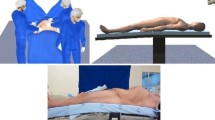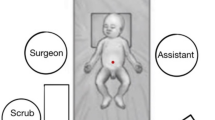Abstract
Background
Transvaginal natural orifice transluminal endoscopic surgery (NOTES) procedures are at the forefront of minimally invasive innovation, remarkable for shorter recovery times and decreased postoperative pain [1, 2]. Most transvaginal procedures are performed as hybrid procedures [3]. To our knowledge, this is the first video depiction of a pure transvaginal umbilical hernia repair in a human.
Methods
This is a 38-year-old woman, body mass index 36.4 kg/m2, with a symptomatic port site hernia in the umbilical region after a previous laparoscopic cholecystectomy. The patient was positioned in stirrups in a steep Trendelenburg position. Sterilization of vaginal cavity was performed with 10 % povidone–iodine solution. A 2 cm transverse incision at the posterior fornix was made, and a SILS port (Covidien, North Haven, CT) was introduced. One 12 mm trocar and two 5 mm trocars were placed through SILS port. Standard straight laparoscopic instruments were used. A 12 cm round Parietex mesh (Covidien) was placed in a specimen retrieval bag and deployed into the peritoneal cavity. The mesh was extracted, unfolded in the abdominal cavity, and circumferentially fixated to the abdominal wall with an AbsorbaTack device (Covidien). The colpotomy incision was closed with a running absorbable suture.
Results
The procedure lasted 103 min and was performed on an outpatient basis. No intraoperative complications occurred. The patient was doing well and had no pain or recurrence at 2, 6, and 9 months’ follow-up.
Conclusions
Our initial experience with transvaginal ventral hernia repair in humans suggests that this procedure is feasible and safe. This approach may improve cosmesis and decrease the risk of future ventral hernias. Potential cons may include a longer operative time, mesh infection, and risk of visceral injury with a pure transvaginal approach. As transvaginal surgery evolves, techniques and devices will become increasingly refined to tackle these challenges.
Article PDF
Similar content being viewed by others
References
Roberts KE, Solomon D, Mirensky T, Silasi DA, Duffy AJ, Rutherford T, Longo WE, Bell RL (2012) Pure transvaginal appendectomy versus traditional laparoscopic appendectomy for acute appendicitis: a prospective cohort study. Ann Surg 255:266–269
McGee MF, Rosen MJ, Marks J, Onders RP, Chak A, Faulx A, Chen VK, Ponsky J (2006) A primer on natural orifice transluminal endoscopic surgery: building a new paradigm. Surg Innov 13:86–93
Auyang ED, Santos BF, Enter DH, Hungness ES, Soper NJ (2011) Natural orifice translumenal endoscopic surgery (NOTES(®)): a technical review. Surg Endosc 25:3135–3148
Author information
Authors and Affiliations
Corresponding author
Electronic supplementary material
Below is the link to the electronic supplementary material.
Supplementary material 1 (WMV 85716 kb)
Rights and permissions
About this article
Cite this article
Wood, S.G., Panait, L., Bell, R.L. et al. Pure transvaginal umbilical hernia repair. Surg Endosc 27, 2966 (2013). https://doi.org/10.1007/s00464-013-2847-1
Received:
Accepted:
Published:
Issue Date:
DOI: https://doi.org/10.1007/s00464-013-2847-1




